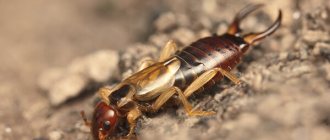Most of us shudder at the words “house rats”: we immediately think of rather large rodent pests that can not only cause damage to property, but also infect them with diseases. But in fact, these animals can be very interesting pets. There are different breeds of rats, but absolutely all of them are distinguished by their amazing intelligence, speed of learning and even good training abilities. Let's get to know them from this side. And at the same time we will learn how to care for a pet rat.
Types of rats
Science knows about 70 species of rats. Among them there are quite exotic and little-studied rodents that live in remote and sparsely populated corners of the planet. There are not many species with which humans have to constantly fight for their territory. The ones found everywhere in Russia can be counted on one hand. The largest and most common species is the gray rat (pasyuk)
. The average body length of adult individuals is 25 centimeters, excluding the tail. The characteristic features of this species are a short tail relative to the body and a fairly wide muzzle with a rounded nose. The coat color is grey. Pasyuk values water in the immediate vicinity of his home, and therefore often settles on the banks of ponds or other water sources. In a metropolis, sewers and basements are the most suitable shelters for them.
Another common species throughout the world is the black rat.
. It is slightly smaller than the pasyuk - its average size is 22 centimeters. But the length of the tail, densely covered with hair, reaches 30 centimeters. It is characterized by large rounded ears and a sharp muzzle. The coat color is usually black-brown with a greenish tint, but there may be other options. The black rat, unlike the gray rat, is not so attached to water, and therefore feels great in any environment. Lives in forests, gardens, parks. In metropolitan areas, it often lives in landfills. He likes to live in attics, for which he received the nickname of the roof rat. However, it could well be called a ship rat, since it is the common inhabitant of sea and river vessels.
The third most widespread rat in the world is the small rat.
. It differs from its relatives in its small size - the length of its body is 15 centimeters. The tail is the same size, but unlike the tails of other species, it is completely naked with visually distinguishable subcutaneous rings, as if encircling the tail at certain intervals. This rat is found in the countries of Southeast Asia and the Pacific Islands.
The long-haired rat lives in the deserts of Australia
. The species is notable for its increased reproductive rates.
Silver belly rat
They are distinguished not only by their bright coloring, unusual for rats, but also by their impressive size. The red back and tail contrast with the light gray belly. An adult grows to the average size of a cat - its body length can reach 40 centimeters.
Rat for home keeping: features, types, maintenance
So, a tame rat is not at all the same as a wild one. Rodents very quickly become attached to humans, learn to recognize their owner, and most importantly, delight with interesting behavior and funny habits. There are a variety of breeds of domestic rats, the most popular are:
- Rex rat . This is that funny “curly”, the structure of which curls like a lamb’s.
- Sphinxes . It’s the same thing as a similar breed of cat: a complete lack of fur.
- White. One of the most beloved by breeders, it is distinguished by its even snow-white color.
- Hooded. It is called so because of its coloring: the dark “hood” seems to lie on the head, while the back and abdomen remain white. One of the most common.
- Blue. One of the most beautiful options. The coat color has an even, blue tint, and the paws are usually the same. But the belly may be lighter.
If you are interested in keeping a decorative rat, but do not know which breed to choose, choose based on appearance. Because almost everyone’s character is soft and friendly. Contrary to fears, the domestic rat almost never bites. To throw her out of balance and cause aggression, you need to try very hard. And yet, do not allow the child to torture the animal; explain that the animal can be petted, called affectionately, placed on the shoulder, but you should not hurt or frighten it.
For proper maintenance, you will definitely need special cages for rats. These dwellings are significantly different from bird dwellings. They are made in a horizontal section, low, but wide and elongated. In principle, it is not difficult to create a house for a rat with your own hands, but you will have to take into account the peculiarity of the pet. This is a rodent that can easily cope with any type of wood. That is why it is best to use transparent plastic or plexiglass, having previously made holes in it for ventilation.
Where do rats live and what do they eat?
Rats live everywhere. In the wild they live:
- In forests;
- In the fields;
- In deserts;
- On the banks of reservoirs;
- Wherever they are able to get their own food.
Rats settle in populated areas:
- In the basements;
- In attics;
- In garages;
- In barns;
- In warehouses;
- In food storage;
- In production premises;
- In landfills;
- In sewers;
- In the cellars;
- In barns;
- And even in apartments;
FACT
The range of temperatures comfortable for rats to live and reproduce is incredibly wide. They feel great and reproduce safely at air temperatures from minus 20 to plus 50.
Rats are omnivores and very voracious. They feed on both plant and animal foods. In the absence of food for a long time, they are able to devour each other and their offspring.
FACT
Rats cannot tolerate hunger or thirst at all. Without food, a rat will not survive even three days! Even less without water. Two days without life-giving moisture can kill a rodent.
Maybe this is why rats are incredibly thrifty. The fear of being hungry prompts the rat to continuously carry food into its hole. Those who managed to stumble upon a rat's pantry simply threw up their hands in surprise - these supplies could feed an entire family for months. Among the rat's supplies you can find several buckets of potatoes, carrots and other vegetables. Sausages, cheeses, eggs, just in commercial quantities. There is also no shortage of cereals and cereals. Rats are known to consume one fifth of the world's grain crops.
How to choose a decorative rat?
When choosing a decorative rat, first of all pay attention to how it looks. A healthy rat is inquisitive and nimble, but at the same time calm. The coat should be smooth and shiny, the eyes and nose should be free of discharge. Do not pick up a rat that is sneezing or making gurgling noises.
It is better to take a decorative rat at the age of 4 weeks or older.
If you have other rats living with you, do not forget that the new “guest” must spend at least 10 days in quarantine - preferably in another room.
Never leave two unfamiliar adult rats unattended - they can injure and even kill each other.
How dangerous are rats to humans?
Rats are a serious threat to human health. Under certain circumstances, rats can destroy as many human lives as sometimes even war does not claim. So in the 16th century, rats killed a third of the population of all of Europe, bringing here the plague, the epidemic of which spread across the continent like wildfire. These inhabitants of garbage dumps, city dumps and sewers are carriers of more than eighty different diseases, many of which are deadly. This:
- encephalitis;
- sodoku;
- streptobacillosis;
- rabies;
- typhus;
- fever;
- cryptosporidiosis;
- giardiasis;
- leptospirosis;
- tularemia;
- listeriosis;
- tuberculosis;
- hepatitis;
- salmonellosis;
- toxoplasmosis;
- plague.
INTERESTING
It is surprising that, being walking death that mows down people, the rats themselves remain unharmed - all the infections and viruses that they carry do not affect their own health in any way! These tenacious creatures are resistant even to strong doses of radiation.
In addition to the obvious threat to health, rats also cause serious economic damage to humans. It is difficult to calculate all the colossal damage to agriculture, private gardens and vegetable gardens. Rodents destroy grain crops, root crops, seedlings, seedlings, fruit trees, and fruits literally on an industrial scale.
Breeds of domestic rats
Today there are 137 species of domestic rats, as well as 570 subspecies . And each of them is interesting in its own way. The most common:
- breed of decorative rat - standard,
- tailless rats,
- rexes and double rexes,
- satin types,
- hairless,
- decorative dumbo rats,
- downy
At the same time, the color of decorative rats can be uniform, ticked (with a pattern) or combined. White domestic rats, gray domestic rats, and black decorative rats are often found. Less often - with hearts, spots and stripes.
Organizations carrying out pest control
Since rats are a scourge throughout the country, the issue of their destruction is decided at the state level. There is even a law of the Russian Federation obliging the heads of administrations of all settlements and all legal entities to engage in pest control in the territory under their jurisdiction. This does not mean that they themselves must destroy all the rats - their task is to ensure the result by hiring professionals in the field of pest control. The direct performers of this work at the moment are exclusively private companies that provide disinsection, disinfection and deratization services to both individuals and legal entities. In socialist Russia, this function was performed by state sanitary and epidemiological stations, but now they are entrusted only with the tasks of supervision, control and scientific research. Entrusting the direct extermination of rats to private companies was a strategically correct decision - in a competitive environment, each performer strives for quality and gives a guarantee for his work. In addition, small companies are able to quickly resolve all issues without bureaucracy and additional approvals. They themselves purchase drugs, equipment and personal protective equipment, ensure the timely replenishment of all resources for successful and uninterrupted work, which clumsy government structures financed by the state budget cannot boast of. The best companies are always those that have entered this market a long time ago and intend to work in this area seriously and for a long time. They have many years of experience, knowledge and a whole arsenal of necessary means for exterminating rats. A striking example of such a successful company is the SES company.
How are rats different from mice?
Many people make the mistake of trying to determine whether a rodent belongs to one species or another. Most often this is needed when you need to buy an ornamental animal. How to distinguish a large mouse from a water rat (10 effective ways to deal with a water rat) or a Scandinavian rat?
Both types of animals belong to the mouse-like suborder, but they have significant differences:
- Appearance. The body of rats is larger and more muscular. Its length is greater than that of mice, and the weight of the “big brothers” can be several times that of mice.
- Head shape. Mice have triangular faces, slightly flattened from top to bottom. The rat's head is elongated, the back of the head is often raised.
- Eye shape. In mice they are large, often “protruding”. Rats have small eyes.
- Nutrition. Rats are omnivores, and mice prefer to eat plants, cereals, seeds, and nuts.
- Character. Rats are smart and brave, not afraid of people. Mice are shy and try not to be seen by humans.
For your information! In popular mouse-themed memes, rats are often portrayed as stupid and mice as smart. In fact, it's the other way around. Not a single mouse reaches the level of intelligence of the “big brothers”.
How often should deratization be carried out?
Deratization should be carried out as needed, that is, at the first, even indirect, signs of the appearance of rats in the room. Evidence of rodents visiting the site can be their excrement, teeth marks on various surfaces, scattered food, bits of food and other evidence left by the “raiders” at the crime scene. However, according to the law of the Russian Federation, there are a number of social facilities where it is necessary to carry out rat control once a month for preventive purposes in order to eliminate the possibility of rats appearing. Proactive action should be taken in all facilities where food is stored, processed, packaged or prepared. Such objects include:
- Public catering points;
- Enterprises producing or processing products;
- Kindergartens;
- Schools;
- Sanatoriums and holiday homes;
- Hospitals;
- Nursing home;
- Terminals and storage;
- And other similar objects;
Choosing and purchasing a pet rodent
It is better to choose animals from nurseries or pet stores that provide proper maintenance and care. Depending on the breed of rat, the rodent may be calm or playful. Females are more temperamental and inquisitive; males, on the contrary, are phlegmatic and can “mark” territory.
It is better to purchase an animal that has reached 1 month. At this age, animals adapt well and quickly get used to people and communication. Older rodents are capable of reproduction, so by purchasing a 2-month-old female, the owner can become the owner of offspring.
A healthy decorative rat has shiny fur, smooth skin and correct body proportions corresponding to the breed. There should be no wounds, ulcers or cuts on the body. As a rule, several individuals live in a cage, who contact each other, play and avoid loneliness in every possible way. During communication, a healthy rodent will show natural curiosity, while a sick rodent will hide in a far corner.
When purchasing a pet, be sure to check the composition of the diet to avoid sudden changes in nutrition and deterioration of stomach function.
Basic pest control tools
Man has been waging war against rats since those ancient times, when neither tools as such nor the very concept of deratization existed. In those distant times, the most popular and effective method of exterminating rats was biological, that is, using cats, dogs and the rats themselves. Here, humans took advantage of the noted tendency of rodents to cruelty and cannibalism. People artificially created a “rat king.” Several rats were caught and placed in a confined space without food. Rats cannot stand hunger, so after a couple of days they begin to eat each other. The winner, the strongest surviving rat, was fed for some time with weakened relatives in order to finally become accustomed to a certain feeding style. Then this monster was released into the territory to be “cleaned up.” All the work of exterminating rats was done with the hands, or rather, with the teeth of the rats themselves. Simple, like everything ingenious. It is not surprising that the sophisticated and resourceful human brain eventually came up with other ways to combat rodents. Today, any city dweller has a much wider choice of them than a caveman. So everyone can satisfy their preferences.
Rat traps
The most common and simple trap is a regular mechanical rat trap with a spring.
.
There are many modifications, but they all work on the same principle - the spring straightens when you touch the nozzle with bait and the gripping mechanism pinches the rodent's head. The advantages of this method are ease of use, lack of dependence on the electrical network, and ease of installation. The disadvantage of this device is that the mechanism operates blindly once and can easily “miss”. Rats have a good reaction and well-developed intuition, which allows them to dodge danger in time. More reliable traps in this regard are adhesive traps
- they do not allow the rodent to escape, securely gluing the paws to the base of the structure. Another advantage of these devices is that there is no need to remove the corpse from the trap - they are disposable and are disposed of along with the rat.
Poisoned Bait
There are a lot of poisons for rats, both in form and content. Granules, briquettes, liquids - they all have a detrimental effect on rats. Depending on the active substance, the death of the rodent occurs within 1 to 15 days. Poisons with the active substance diphasinon kill rodents slowly. Repeated administration of the drug is required for a lethal dose. Substances containing brodifacoum or bromadiolone act faster; a rat only needs to try the poisonous bait once for it to go to another world. The most powerful rat poison with an immediate effect is based on strychnine, thallium salts, lead, phosphorus, and arsenic. Phosphorus damages bone tissue, arsenic affects the nervous system, and other components cause severe poisoning. Preparations based on zoocoumarins have become widespread for home use. You can always find drugs such as:
- Rat Death;
- Storm;
- Nutcracker;
- Goliath;
- Clean house;
- Mortorat;
- Zookoumarin Neo;
- Hedgehog;
- Ratindane;
- Zernotsin;
- Tsunami Extra;
- Varat.
All these poisons are quite toxic and dangerous not only for rats, but also for people and pets. In addition to the risk of poisoning your pets, there is a risk that death will overtake rodents in hard-to-reach places under wall cladding or tiled lining of water pipes. It is almost impossible to remove corpses from such places without destroying the structure. The smell from decaying animals is unbearable and harmful to health. So when choosing rat poison, consider all the risks! If you are not inclined to risk your health, then it is better to consult a specialist.
IMPORTANT
Companies professionally engaged in deratization, firstly, use special closed-type traps in which the poison is inaccessible to children and pets, and secondly, they use new generation drugs with a mummifying effect. After their absorption, the corpse dries out without the spread of unpleasant odors. That is, specialists remove all risks and provide a guarantee for their work.
The rat is a dangerous, cunning and intelligent opponent. You must be prepared to fight him in every way!
Spraying deterrent chemicals
Rats are wary of any strong odors. And from some people they know well, they simply run away. Among them there are aromas of both plant origin and chemical preparations. Plants include peppermint, tansy, and wormwood. These aromas are commercially available in the form of essential oils, in which the concentration of active substances is significantly higher than that of the fresh or dried plant. They can be used undiluted for spraying around the room. Gardeners and summer residents can be recommended to plant black elderberry around the house and beds. The roots of the plant release cyanide into the soil. However, all parts of the plant contain hydrocyanic acid to one degree or another and are a strong poison for rats. They avoid the danger they know well.
Among chemical substances, rats are particularly disliked by ammonia; however, any insecticides with a pungent odor are suitable for spraying indoors.
Another smell that serves as a signal to escape is the smell of burning wool. Our ancestors, in order to drive rats out of their territory, burned one killed rodent and left it where rats got into the habit of visiting - in a barn, cellar, barn. So to speak, a demonstrative execution for the edification of the entire tribe. To use this ancient method of repelling rats, it is not necessary to catch and kill the animal - you can just as easily set fire to a piece of any natural fur or wool. This source of smell can be left for some time even in a city apartment.
Ultrasonic repellers
Rats communicate with each other using ultrasound, so they react to ultrasonic waves and listen warily to their radiation. If they sense a distress signal, a threat, or obvious danger, they take flight. If the manufacturers of the ultrasonic repeller did not bother to ensure that the signal was exactly the same, then the rats very soon get used to the monotonous impulses and stop responding to them. We must not forget that the rat is not just a very smart animal, but a highly intelligent creature with excellent instincts - it is quite capable of distinguishing a real threat from an imaginary one. At the moment, the market offers a large selection of rat repellers of varying power.
On sale you can find devices designed both for the area of a small apartment and for large-scale industrial premises.
One of the most famous brands is the Grad ultrasonic repeller. Various modifications of the installation operate in the range from 500 to 1200 square meters, have a unique sound pattern based on the biorhythms of rodents and are equipped with several emitters that send impulses in different directions. Many models of this brand are capable of operating autonomously, without requiring constant connection to the electrical network. All these models can be successfully used in production. For small apartments, we can recommend a set of three Weitech WK-3523 ultrasonic repellers. Each of the three devices in the set is equipped with a plug and is plugged directly into the outlet as a fumigator. You can use one device or all three in different rooms. Each of them has a repellent area of 45 square meters. The devices operate silently and are designed for round-the-clock operation. You can only check how effectively this product will protect you from rodents empirically. A person approaches the extermination of rats, as well as other everyday problems, with his own standards, principles, and preferences. Of all the methods of controlling rodents, everyone can choose the best one for themselves. Eliseeva Natalya Viktorovna
What to feed a decorative rat?
The decorative rat is an omnivore, but this does not mean that it can be fed with table scraps.
You should not feed your rat the following foods:
- Sweet.
- Roast.
- Smoked.
- Very salty.
- Spices.
- Pickled.
- Alcohol and carbonated drinks.
- Chocolate and everything containing it.
- The following vegetables are raw: potatoes, sorrel, cabbage, spinach.
- Fresh pastries and bread.
What to feed a decorative rat? A grain mixture for rats and water should be available at all times. The water is changed daily.
The food for a decorative rat is renewed 2 times a day (for pregnant females - 3-4 times a day).
The rat can also be given boiled meat, porridge in water, vegetables (raw and cooked), fruits, dairy products, crackers, nuts, lettuce and dandelion leaves.
Juices can cause allergies in rats.











